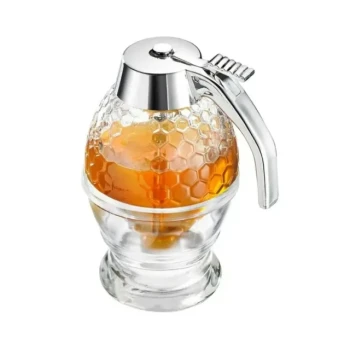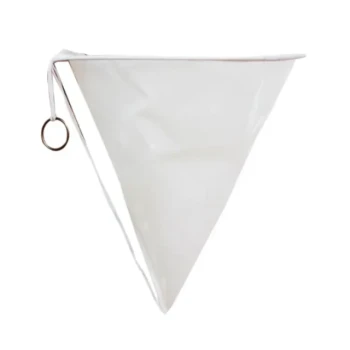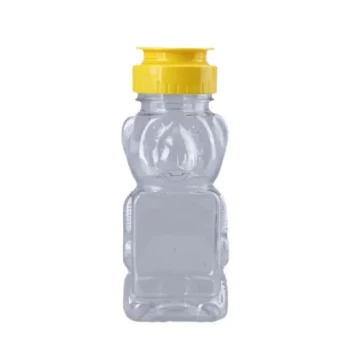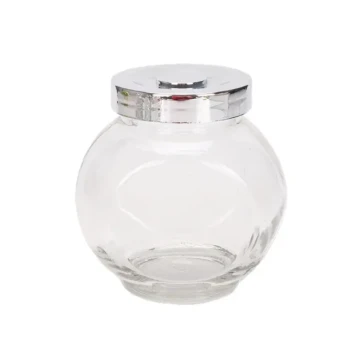In short, the primary benefit of honey cappings is their unique and potent composition. As the final beeswax seal on a honeycomb cell, cappings are a composite material containing not just pure beeswax, but also raw honey, enzyme-rich bee saliva, pollen, and propolis. This makes them one of the most nutritionally dense and beneficial products from the hive.
The true value of honey cappings is not in any single component, but in their synergistic blend. They represent the most unfiltered and concentrated form of the hive's protective and nutritional elements, offering a richer profile of enzymes and antibacterial compounds than processed honey alone.
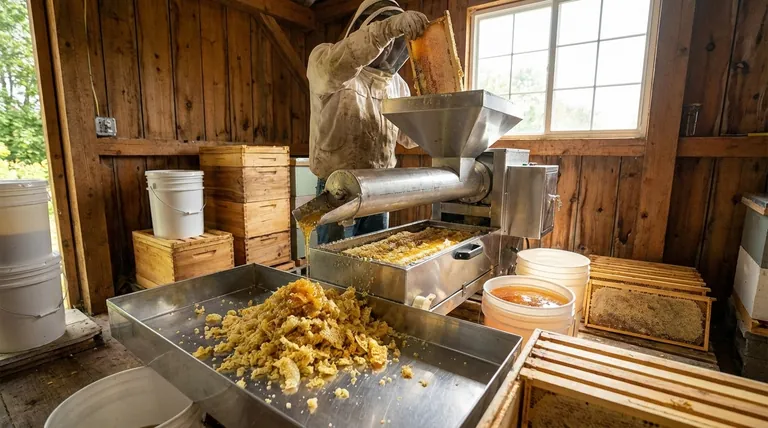
What Exactly Are Honey Cappings?
To appreciate their benefits, you must first understand their function within the hive. Cappings are not just a simple lid; they are a complex biological seal created with a specific purpose.
The Final Seal of Perfection
Honeybees fill honeycomb cells with nectar, which they fan with their wings to dehydrate. When the honey reaches the perfect moisture content—typically below 18%—the bees seal the cell with a fresh layer of wax. This capping is critical; it protects the finished honey from absorbing atmospheric moisture, which would cause it to ferment and spoil.
A Composite of Hive Products
The key to the cappings' benefits is that they are never just pure wax. When a beekeeper slices them off the frame to harvest the honey, the cappings are saturated with several substances:
- Raw Honey: The most immediate and delicious component.
- Beeswax: A natural and edible wax with protective properties.
- Propolis: A resinous substance bees collect from trees, used as a powerful antibacterial, antiviral, and antifungal agent to seal the hive.
- Pollen: Small amounts of pollen become trapped in the cappings, representing the local flora.
The Concentrated Health Benefits
Because of this unique mixture, consuming honey cappings (often sold as "chunk honey" or on its own) provides benefits that may exceed that of liquid honey.
Enhanced Antibacterial Power
While all raw honey has antibacterial properties, cappings are enriched with propolis and a higher concentration of enzymes like lysozyme from bee saliva. This combination makes the honey clinging to the cappings particularly effective at inhibiting microbial growth.
A Rich Source of Live Enzymes
The honey closest to the cappings is the freshest and least disturbed. It is exceptionally rich in natural enzymes like diastase and invertase, which bees use to transform nectar into honey. These delicate enzymes are crucial for digestion and are easily destroyed by heat and processing, making cappings a superior source.
Potential Seasonal Allergy Relief
Cappings contain small, trapped granules of local pollen. The theory of honey as an allergy aid is that consuming this local pollen can act as a form of immunotherapy, helping your body build a tolerance to allergens in your environment. Chewing on the cappings maximizes your exposure to these compounds.
Understanding the Trade-offs and Misconceptions
It's important to separate the evidence-based benefits from folklore. The potency of honey and its byproducts has led to some exaggerated claims.
Fact vs. Folklore
You may hear dramatic stories about honey's preservative power, such as its use in mummification. While honey's low moisture content and antimicrobial properties make it an incredible natural preservative, these stories are an extreme metaphor for its effects. Cappings are a powerful natural product, not a magical substance.
Not a Miracle Cure
While many people report significant relief from seasonal allergies by consuming cappings, this is not a guaranteed medical treatment. The benefits are based on plausible theories and anecdotal evidence but should be seen as a complementary wellness practice rather than a replacement for medical advice.
The Challenge of Sourcing
Pure honey cappings are a specialty product. They represent a very small fraction of the total honey harvest and require careful separation. For this reason, they can be more difficult to find and more expensive than standard raw honey.
How to Best Use Honey Cappings
To get the most out of this unique product, align your method of consumption with your goal.
- If your primary focus is seasonal allergy relief: Chew the cappings like a natural piece of gum for 5-10 minutes, allowing for maximum absorption of the pollen and propolis before swallowing the honey-infused wax.
- If your primary focus is general wellness and enzyme intake: Consume a small spoonful of the cappings directly or dissolve them in warm (never hot) water or tea to preserve their delicate enzymatic structure.
- If your primary focus is natural skincare: While honey itself is a fantastic humectant for skin, using sticky cappings directly is impractical. It is better to seek out skincare products that specifically incorporate high-quality beeswax and raw honey extracts.
Ultimately, honey cappings offer the most direct and unfiltered way to experience the concentrated essence of the beehive.
Summary Table:
| Benefit | Key Components | Primary Use |
|---|---|---|
| Enhanced Antibacterial Power | Propolis, Lysozyme | Inhibiting microbial growth |
| Rich Source of Live Enzymes | Diastase, Invertase | Supporting digestion & wellness |
| Potential Allergy Relief | Local Pollen | Building tolerance to environmental allergens |
Ready to harness the power of the hive for your customers?
As a leading wholesale supplier to commercial apiaries and beekeeping equipment distributors, HONESTBEE provides the high-quality supplies and equipment you need to efficiently harvest and process valuable hive products like honey cappings. From uncapping tools to filtration systems, we help you maximize your yield and product quality.
Contact our expert team today to discuss your wholesale needs and discover how our products can support your business's success.
Visual Guide
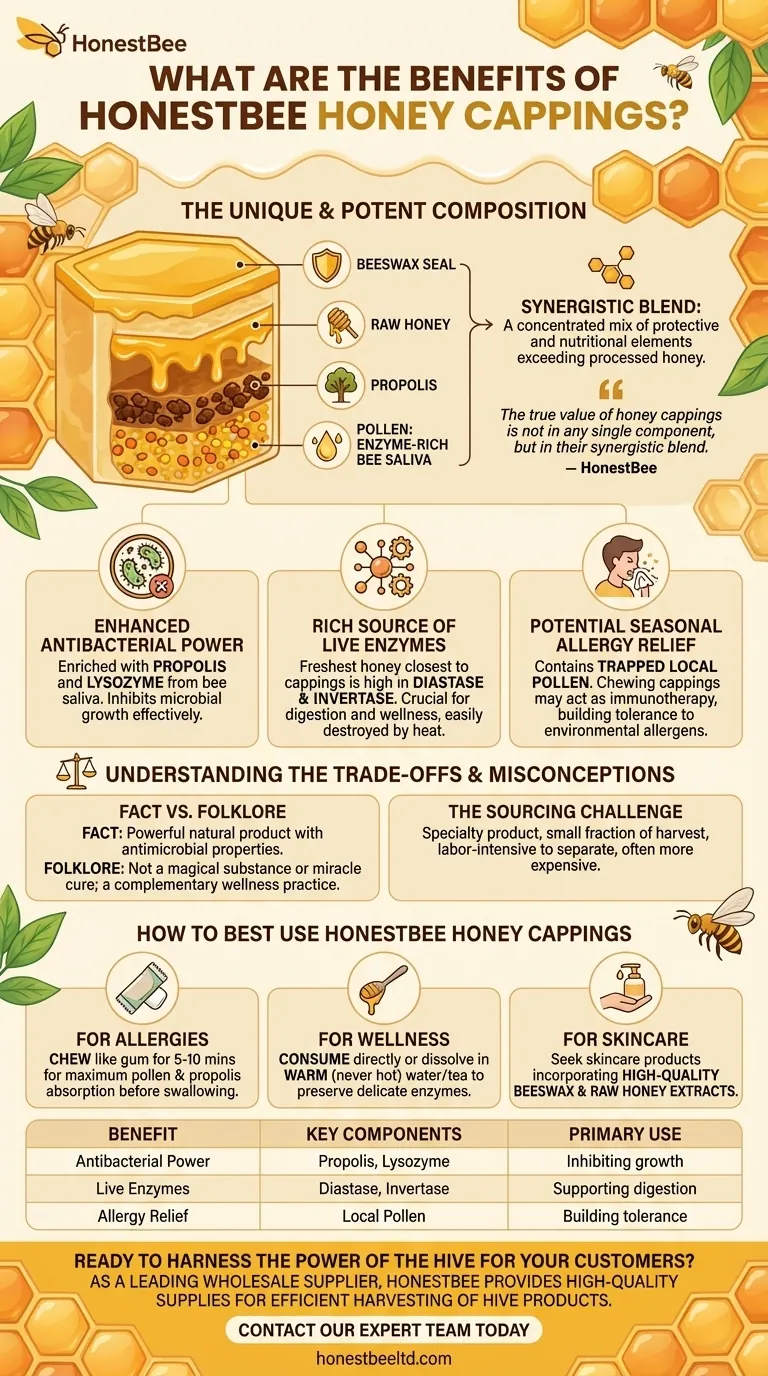
Related Products
- Honey Wax Separating Wax Press with Metal Screw Wax Separator Machine
- 10L Stainless Steel Honey Wax Press Extractor for Wax Cappings
- Easy Use Manual Stainless Steel Honey Press for Honey Comb
- Automatic Honey Frame Uncapper Machine for Beekeeping
- Colorful Silicone Beeswax Foundation Mold Mould for Beekeeping
People Also Ask
- What happens to the remaining wax in the Wax Screw Presses set? A Guide to Efficient Honey & Wax Separation
- How does the honey screw press operate? A Guide to Maximizing Honey Yield from Cappings
- What is the purpose of the Wax Screw Presses set? Maximize Honey & Wax Yield Efficiently
- How can remaining honey be removed from wax cappings after straining? Maximize Your Harvest Yield
- What is a honey press and what is it used for? A Guide to Simple Honey Extraction





